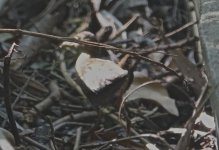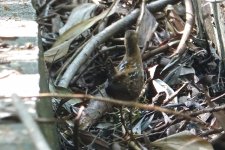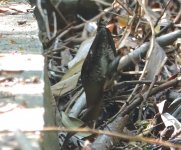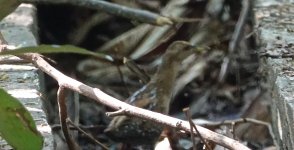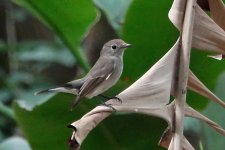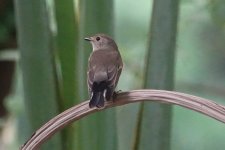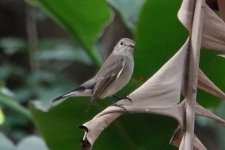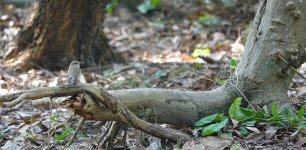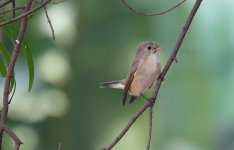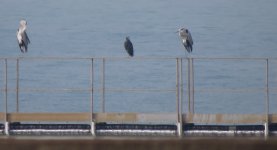-
Welcome to BirdForum, the internet's largest birding community with thousands of members from all over the world. The forums are dedicated to wild birds, birding, binoculars and equipment and all that goes with it.
Please register for an account to take part in the discussions in the forum, post your pictures in the gallery and more.
You are using an out of date browser. It may not display this or other websites correctly.
You should upgrade or use an alternative browser.
You should upgrade or use an alternative browser.
The Magic Roundabout (5 Viewers)
- Thread starter MKinHK
- Start date
More options
Who Replied?MKinHK
Mike Kilburn

After a break I can't quite believe is almost a month due to big work pressure, work trips and holidays I finally got back on the patch on Monday and again on Wednesday and Thursday.
The star bird was my first Yellow Bittern(175) which came up from one of the fairways on the golf course and plunged into the taller verge next to the clubhouse.
Other migrants included a simillima Yellow Wagtail (there had been three on Monday) and four long-staying Red Turtle Doves, and I wonder if a solitary Richard's Pipit might be a local breeder.
Wednesday produced a high count of 11 Cattle Egrets, with eight on Thursday and four on Monday there were up to 20 Black-crowned Night Herons roosting in the trees along the grassy strip, plus a couple of Grey Herons and a maximum of four Great Egrets.
Successful breeders include Spotted Doves, Crested Mynas and Black-collared Starlings, and I was pleased to pick up a Sooty-headed Bulbul as well as Chinese and Crested Bulbuls yesterday.Other lingerers include a Magpie, a rather late philippensis Blue Rock Thrush and a pair of Scaly-breasted Munias.
Cheers
Mike
The star bird was my first Yellow Bittern(175) which came up from one of the fairways on the golf course and plunged into the taller verge next to the clubhouse.
Other migrants included a simillima Yellow Wagtail (there had been three on Monday) and four long-staying Red Turtle Doves, and I wonder if a solitary Richard's Pipit might be a local breeder.
Wednesday produced a high count of 11 Cattle Egrets, with eight on Thursday and four on Monday there were up to 20 Black-crowned Night Herons roosting in the trees along the grassy strip, plus a couple of Grey Herons and a maximum of four Great Egrets.
Successful breeders include Spotted Doves, Crested Mynas and Black-collared Starlings, and I was pleased to pick up a Sooty-headed Bulbul as well as Chinese and Crested Bulbuls yesterday.Other lingerers include a Magpie, a rather late philippensis Blue Rock Thrush and a pair of Scaly-breasted Munias.
Cheers
Mike
MKinHK
Mike Kilburn

During a very hot and quiet spell an Osprey flying over the bridge connecting the airport island to Lantau was a nice surprise last Friday, especially as it was just inside my extended recording area, which includes birds seen on my commute to and from work.
Thsi brings the number of birds recorded on the patch this month to 79 - which exceeds the previous record for this quarter (Q2 of 2013) by a whopping 25 species!
I'll post separately on the highlights of this last quarter and the prospects for July-September 2016.
Cheers
Mike
Thsi brings the number of birds recorded on the patch this month to 79 - which exceeds the previous record for this quarter (Q2 of 2013) by a whopping 25 species!
I'll post separately on the highlights of this last quarter and the prospects for July-September 2016.
Cheers
Mike

Has the Magic Roundabout disappeared?
thirudevaram
Trapped in mist ***s
My exact thoughts.Has the Magic Roundabout disappeared?
MKinHK
Mike Kilburn

Things are looking rather bleak I'm afraid.
The golf course is gone and the Northern Edge and the tangles are being prepped for more works as the construction of the new third runway gets underway.
I did get out a couple of times the week before last and picked up a Yellow-rumped Flycatcher and an Arctic Warbler on one day and another Arctic Warbler on the other, but I had no free lunchtimes last week due to rain and meetings.
I did see 8 Cattle Egrets on the remnants of the golf course from a window in Terminal 2 at lunchtime today, but really hoping for some passerines on the Core Area to keep me interested.
Cheers
Mike
The golf course is gone and the Northern Edge and the tangles are being prepped for more works as the construction of the new third runway gets underway.
I did get out a couple of times the week before last and picked up a Yellow-rumped Flycatcher and an Arctic Warbler on one day and another Arctic Warbler on the other, but I had no free lunchtimes last week due to rain and meetings.
I did see 8 Cattle Egrets on the remnants of the golf course from a window in Terminal 2 at lunchtime today, but really hoping for some passerines on the Core Area to keep me interested.
Cheers
Mike
thirudevaram
Trapped in mist ***s
Mike, very sorry to hear that roundabout is shrinking. But, i guess it was supposed to happen as the HK airport is growing.
We have missed the Yellow-rumped Flycatcher this fall, i guess its bit late now. Sheer no of Blue and White Flycatchers are here right now(6 adult males all perched at a same branch in a undergrowth). Hope you will be getting some variety in the next few weeks.
We have missed the Yellow-rumped Flycatcher this fall, i guess its bit late now. Sheer no of Blue and White Flycatchers are here right now(6 adult males all perched at a same branch in a undergrowth). Hope you will be getting some variety in the next few weeks.
MKinHK
Mike Kilburn

And . . . we're back!
Last week I noticed from the bus that the ground truthing equipment in the main roundabout was steadily being removed so I made a couple of swift visits to see how it looked.
An Asian Brown Flycatcher hunting from a waters sprinkler on the Grassy Patch immediately made me wish I'd brought a camera. A Red-throated Flycatcher, a Yellow-browed Flycatcher and a couple of Dusky Warblers plus an Oriental Turtle Dove added a little more interest on my second visit.
Monday was an altogether more birdy although Asian Brown Flycatcher was again the first bird to show as the first of four Dusky Warblers called. four or five Olive-backed Pipits and a couple of male Chinese Blackbirds immediately set the tone that, despite the 27 degree temperatures, winter was here.
Just as it was starting to feel a bit quiet the Red-throated Flycatcher called and a Yellow-browed Warbler showed nicely. Crossing over to the Eastern Tangle the Red-throated Flycatcher popped up again and then showed nicely and called persistently for a couple of minutes without ever offering a shot.
I got onto an odd-looking long-tailed-looking Dusky Warbler that was feeding higher up in the trees and in a manner than just didn't suggest Dusky, but really didn't offer itself as anything else. I was soon distracted away by just my second Japanese Paradise Flycatcher on the patch. This was a rather dowdy grey headed and breasted female with an almost khaki tint to the upper parts and tail - a plumage I've never seen previously.
As I was getting bad shots of it a movement in the wet leaf-filled ditch that runs along the length of the Tangles caught my eye, as a thrush-sized head popped up to look at me. When it didn't shoot off at high speed with a panicked steep, but turned around and started walking slowly away along the ditch I knew I had a Baillon's Crake (176) - a bird I have dreamed of finding here doing exactly that - every autumn for the last five years!
I fired off a few very poor shots before it disappeared under the last of the soil boring machines that straddled the ditch. One of these shots shows the short primary projection which confirms that this is indeed Baillon's and not Little Crake - an much anticipated species in Hong Kong. As the bird slipped away down the bank and into the undergrowth I fired off one more hopeless shot and with great reluctance (and a bubbling elation) headed back to the office to discuss waste management, community investment and other worthy, but much less exciting, subjects.
Cheers
Mike
Last week I noticed from the bus that the ground truthing equipment in the main roundabout was steadily being removed so I made a couple of swift visits to see how it looked.
An Asian Brown Flycatcher hunting from a waters sprinkler on the Grassy Patch immediately made me wish I'd brought a camera. A Red-throated Flycatcher, a Yellow-browed Flycatcher and a couple of Dusky Warblers plus an Oriental Turtle Dove added a little more interest on my second visit.
Monday was an altogether more birdy although Asian Brown Flycatcher was again the first bird to show as the first of four Dusky Warblers called. four or five Olive-backed Pipits and a couple of male Chinese Blackbirds immediately set the tone that, despite the 27 degree temperatures, winter was here.
Just as it was starting to feel a bit quiet the Red-throated Flycatcher called and a Yellow-browed Warbler showed nicely. Crossing over to the Eastern Tangle the Red-throated Flycatcher popped up again and then showed nicely and called persistently for a couple of minutes without ever offering a shot.
I got onto an odd-looking long-tailed-looking Dusky Warbler that was feeding higher up in the trees and in a manner than just didn't suggest Dusky, but really didn't offer itself as anything else. I was soon distracted away by just my second Japanese Paradise Flycatcher on the patch. This was a rather dowdy grey headed and breasted female with an almost khaki tint to the upper parts and tail - a plumage I've never seen previously.
As I was getting bad shots of it a movement in the wet leaf-filled ditch that runs along the length of the Tangles caught my eye, as a thrush-sized head popped up to look at me. When it didn't shoot off at high speed with a panicked steep, but turned around and started walking slowly away along the ditch I knew I had a Baillon's Crake (176) - a bird I have dreamed of finding here doing exactly that - every autumn for the last five years!
I fired off a few very poor shots before it disappeared under the last of the soil boring machines that straddled the ditch. One of these shots shows the short primary projection which confirms that this is indeed Baillon's and not Little Crake - an much anticipated species in Hong Kong. As the bird slipped away down the bank and into the undergrowth I fired off one more hopeless shot and with great reluctance (and a bubbling elation) headed back to the office to discuss waste management, community investment and other worthy, but much less exciting, subjects.
Cheers
Mike
Attachments
Last edited:
thirudevaram
Trapped in mist ***s
Wow, Congrats Mike! Swinhoe's next.
Jeff Hopkins
Just another...observer

Great find, Mike. The patch never ceases to amaze.
MKinHK
Mike Kilburn

Dev - I like the way you're thinking. Its not impossible - A Swinhoe's was recorded a little distance up the Pearl River over 100 years ago . . .
Thanks Jeff - me too!
Today was quieter and sadly with no Baillon's Crake, but Daurian Redstarts had arrived - at least three were present, along with two very vocal Taiga Flycatchers chasing each other about the Western Tangle. Also among the usual suspects were a large cettia Bush Warbler sp.. IIRC these very large chestnut-crowned birds are Manchurian Bush Warbler, but I'm happy to be corrected.
Other bits and pieces included a couple of unidentified thrushes at least two and possibly three Asian Brown Flycatchers, the same number of Dusky Warblers and a Yellow-browed Warbler.
Cheers
Mike
Thanks Jeff - me too!
Today was quieter and sadly with no Baillon's Crake, but Daurian Redstarts had arrived - at least three were present, along with two very vocal Taiga Flycatchers chasing each other about the Western Tangle. Also among the usual suspects were a large cettia Bush Warbler sp.. IIRC these very large chestnut-crowned birds are Manchurian Bush Warbler, but I'm happy to be corrected.
Other bits and pieces included a couple of unidentified thrushes at least two and possibly three Asian Brown Flycatchers, the same number of Dusky Warblers and a Yellow-browed Warbler.
Cheers
Mike
MKinHK
Mike Kilburn

More quality today in the shape a a long-tailed brown flash across the Core Area which revealed itself as a fine rufous-crowned brown-masked female Bull-headed Shrike which came close a couple of times including a curiosity dive-bombing, but never for long enough for a photo. This is just my second record for the patch, following one that turned up exactly a week earlier in November 2013.
Other good birds included a rather drab female Black-naped Monarch that I first picked up on call, and a female Fork-tailed Sunbird. But the real stars were the two Taiga Flycatchers one of which posed beautifully on a dried out palm stem enabling me to zoom in with the teleconverter function on the RX10iii (bizarrely only when the image quality is set to low).
For the first time I had a really good opportunity to capture the difference in colour between the tail and upper tail coverts that is so often quoted as a good feature to separate Taiga from Red-breasted but so often impossible to see in the field. A few grainy photos show the limitations of zooming in so close on this setting in low light, but do at least illustrate the key colours.
Cheers
Mike
Other good birds included a rather drab female Black-naped Monarch that I first picked up on call, and a female Fork-tailed Sunbird. But the real stars were the two Taiga Flycatchers one of which posed beautifully on a dried out palm stem enabling me to zoom in with the teleconverter function on the RX10iii (bizarrely only when the image quality is set to low).
For the first time I had a really good opportunity to capture the difference in colour between the tail and upper tail coverts that is so often quoted as a good feature to separate Taiga from Red-breasted but so often impossible to see in the field. A few grainy photos show the limitations of zooming in so close on this setting in low light, but do at least illustrate the key colours.
Cheers
Mike
Attachments
Last edited:
MKinHK
Mike Kilburn

A 40 minute lunchtime interlude on the Magic Roundabout turned out very productive as the overnight and morning rain dropped two Richard's Pipits, and a female Stejneger's Stonechat on the Grassy Edge along with the Olive-backed Pipits and a newly-arrived Grey-headed Flycatcher on the core area along with the female Black-naped Monarch, an Asian Brown Flycatcher and a typically noisy Taiga Flycatcher. A yellow-browed Warbler and something intriguing that scuttled away under a hedge completed the ensemble for the day.
Cheers
Mike
Cheers
Mike
MKinHK
Mike Kilburn

What a cracking week its been!
Three patch ticks in as may days is a definite sign of late autumn that really makes me wish I hadn't lost all those days earlier in October (and indeed September), or I might be knocking on the 200 species milestone. As it is the three new species bring the list to 179 and I've learned of another addition - an adult White-breasted Waterhen found patrolling the same ditch as the Baillon's Crake by Graham Talbot on Sunday.
Graham had a good day on Sunday - finding a decent range of buntings, thrushes and flycatchers that had me raring to go come Monday lunchtime. I didn't get onto the golf course which, as last winter, held the buntings and the Dusky Thrush, but on all three days this week the tangles have held a pair of Japanese Thrushes, at least three Grey-backed Thrushes and I've seen two of a maximum count of four Eye-browed Thrushes. On Monday I also had a couple of Chinese Blackbirds and heard the distinctive rattle of the Dusky Thrush, which presumably had come over for a drink and a wash in the ditch.
I also had the expected quartet of Flycatchers - Asian Brown, Taiga, Grey-headed, and the female Black-naped Monarch. There appear to be at least two Taiga Flycatchers - one of which has a cute little patch of red chin stubble - different from the bird photographed last week but I have been perplexed to be hearing what sounds like a longer more textured call that fits my mental picture of Red-breasted much closer than it does Taiga's zippier buzz.
The dilemma was finally resolved yesterday when Koel Ko, showed a picture of a clear Red-breasted Flycatcher (178) on his camera, and 20 minutes later the same bird popped up on a prominent branch above us and showed an unequivocally pale base to the lower mandible, a much browner general colour scheme. This was a big addition to the list (my 14th flycatcher here!). Its one I have been hoping for as Red-breasted Flycatcher has proven to be increasingly regular in Hong Kong.
The reason that Koel was here was that on Monday I caught a distance glimpse of a rather dark rail/crake in the Western Tangle end of the ditch. On Tuesday I did better, twice flushing up from right under my feet in ditch in the Eastern Tangle. The second time it scuttled away along the ditch and, thinking it was in cover, stopped and turned to look at me for a few seconds. It was substantially larger than the Baillon's and showed an all-brown head, dark chestnut iris and a dark bill with a distinctive but mucky-edged yellow wedge at the base of the bill (broader on the lower mandible and tapering to a point on the rear edge of the culmen). Each time it flushed it showed nothing but dark upperparts and wings. Unfortunately there was such low light that I was not able to pick up any leg colour, but equally there was not hint of any pale colours on the vent or flanks, although I did get an impression of a pale throat when I first saw it on Monday.
As far as my research has shown Brown Crake (177) is the only realistic option, with the uniformity of the plumage and the yellow-based bill being the key features.
This is a pretty big deal as the last Brown Crake in HK was seven or eight years ago, and the gap to the previous one was as long again. It formerly bred, but its now irregular enough to have become a description species for the HKBWS Records Committee.
My third new bird was an immature Blue Whistling Thrush (179) which is altogether commoner, but not known as a migrant or wanderer. It seems that the thrushes are determined to keep up with the flycatchers - this one being my 13th species here. It too was loitering around the ditch, which has this year more than even proven itself to be something of a magnet for thirsty migrants - I also had a female Japanese Thrush rootling about in the leaf litter yesterday and one of the three or four Daurian Redstarts - a showy female - was also taking advantage.
Other bit and pieces this week include a female Fork-tailed Sunbird and a Pallas's Leaf Warbler on Monday, and a Two-barred Greenish Warbler on Tuesday, along with the regular Duskies and YBWs. The interesting "not Dusky" warbler remains in residence, but there are still no decent photos. Ac couple of Oriental Turtle Doves and the regular small flock of Silky Starlings have now arrived and I flushed a roosting Black-crowned Night Heron on Monday. Less usual was a Pacific Reef Egret loafing on the landing lights jetty with a couple of Grey Herons yesterday.
Cheers
Mike
Three patch ticks in as may days is a definite sign of late autumn that really makes me wish I hadn't lost all those days earlier in October (and indeed September), or I might be knocking on the 200 species milestone. As it is the three new species bring the list to 179 and I've learned of another addition - an adult White-breasted Waterhen found patrolling the same ditch as the Baillon's Crake by Graham Talbot on Sunday.
Graham had a good day on Sunday - finding a decent range of buntings, thrushes and flycatchers that had me raring to go come Monday lunchtime. I didn't get onto the golf course which, as last winter, held the buntings and the Dusky Thrush, but on all three days this week the tangles have held a pair of Japanese Thrushes, at least three Grey-backed Thrushes and I've seen two of a maximum count of four Eye-browed Thrushes. On Monday I also had a couple of Chinese Blackbirds and heard the distinctive rattle of the Dusky Thrush, which presumably had come over for a drink and a wash in the ditch.
I also had the expected quartet of Flycatchers - Asian Brown, Taiga, Grey-headed, and the female Black-naped Monarch. There appear to be at least two Taiga Flycatchers - one of which has a cute little patch of red chin stubble - different from the bird photographed last week but I have been perplexed to be hearing what sounds like a longer more textured call that fits my mental picture of Red-breasted much closer than it does Taiga's zippier buzz.
The dilemma was finally resolved yesterday when Koel Ko, showed a picture of a clear Red-breasted Flycatcher (178) on his camera, and 20 minutes later the same bird popped up on a prominent branch above us and showed an unequivocally pale base to the lower mandible, a much browner general colour scheme. This was a big addition to the list (my 14th flycatcher here!). Its one I have been hoping for as Red-breasted Flycatcher has proven to be increasingly regular in Hong Kong.
The reason that Koel was here was that on Monday I caught a distance glimpse of a rather dark rail/crake in the Western Tangle end of the ditch. On Tuesday I did better, twice flushing up from right under my feet in ditch in the Eastern Tangle. The second time it scuttled away along the ditch and, thinking it was in cover, stopped and turned to look at me for a few seconds. It was substantially larger than the Baillon's and showed an all-brown head, dark chestnut iris and a dark bill with a distinctive but mucky-edged yellow wedge at the base of the bill (broader on the lower mandible and tapering to a point on the rear edge of the culmen). Each time it flushed it showed nothing but dark upperparts and wings. Unfortunately there was such low light that I was not able to pick up any leg colour, but equally there was not hint of any pale colours on the vent or flanks, although I did get an impression of a pale throat when I first saw it on Monday.
As far as my research has shown Brown Crake (177) is the only realistic option, with the uniformity of the plumage and the yellow-based bill being the key features.
This is a pretty big deal as the last Brown Crake in HK was seven or eight years ago, and the gap to the previous one was as long again. It formerly bred, but its now irregular enough to have become a description species for the HKBWS Records Committee.
My third new bird was an immature Blue Whistling Thrush (179) which is altogether commoner, but not known as a migrant or wanderer. It seems that the thrushes are determined to keep up with the flycatchers - this one being my 13th species here. It too was loitering around the ditch, which has this year more than even proven itself to be something of a magnet for thirsty migrants - I also had a female Japanese Thrush rootling about in the leaf litter yesterday and one of the three or four Daurian Redstarts - a showy female - was also taking advantage.
Other bit and pieces this week include a female Fork-tailed Sunbird and a Pallas's Leaf Warbler on Monday, and a Two-barred Greenish Warbler on Tuesday, along with the regular Duskies and YBWs. The interesting "not Dusky" warbler remains in residence, but there are still no decent photos. Ac couple of Oriental Turtle Doves and the regular small flock of Silky Starlings have now arrived and I flushed a roosting Black-crowned Night Heron on Monday. Less usual was a Pacific Reef Egret loafing on the landing lights jetty with a couple of Grey Herons yesterday.
Cheers
Mike
Attachments
-
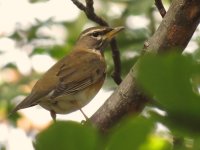 IMG_8806 Eye-browed Thrush @ RDBT.JPG611.9 KB · Views: 56
IMG_8806 Eye-browed Thrush @ RDBT.JPG611.9 KB · Views: 56 -
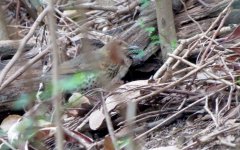 IMG_8785 Japanese Thrush (f) @ RDBT.JPG757.1 KB · Views: 74
IMG_8785 Japanese Thrush (f) @ RDBT.JPG757.1 KB · Views: 74 -
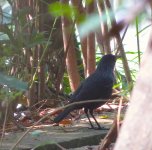 IMG_8803 Blue Whistling Thrush @ RDBT.jpg258.3 KB · Views: 62
IMG_8803 Blue Whistling Thrush @ RDBT.jpg258.3 KB · Views: 62 -
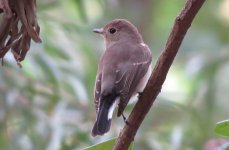 IMG_8793 Taiga Flycatcher @ RDBT.JPG573.3 KB · Views: 67
IMG_8793 Taiga Flycatcher @ RDBT.JPG573.3 KB · Views: 67 -
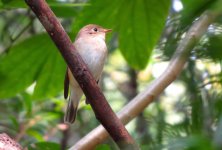 IMG_8799 Red-breasted Flycatcher @ RDBT.JPG576.4 KB · Views: 69
IMG_8799 Red-breasted Flycatcher @ RDBT.JPG576.4 KB · Views: 69
thirudevaram
Trapped in mist ***s
Carnival time and you have all the reasons to celebrate early.
The pale bill of the Red-breasted Flycatcher is a clean shot. The ones we had here over the last two winters were not that obvious.
Kudos, Mike. The come back of the Brown Crake is glorious. I have the "A Photographic Guide to the Birds of Hong Kong", a fantastic resource which i mainly use to practice the Chinese names of birds Which has some great photos of Brown Crake from Nam Chung in 2009.
The pale bill of the Red-breasted Flycatcher is a clean shot. The ones we had here over the last two winters were not that obvious.
Kudos, Mike. The come back of the Brown Crake is glorious. I have the "A Photographic Guide to the Birds of Hong Kong", a fantastic resource which i mainly use to practice the Chinese names of birds Which has some great photos of Brown Crake from Nam Chung in 2009.
MKinHK
Mike Kilburn

Carnival time? - absolutely Dev!
Its great to hear that you find the "Photographic Guide to the Birds of Hong Kong" useful.
. . . and last week actually got even better.
On Friday I went back for another circuit of the Roundabout and while it was quieter it was still terrific to enjoy cracking views of the Red-breasted Flycatcher and a couple of Taiga Flycatchers feeding close to the ground on the core area. Every time I go I reel off a few more shots in the hope of really nailing great comparative shots of this interesting species pair and every time I listen again to compare the calls.
On Sunday, inspired by the good birds of the week, I headed back to the Magic Roundabout with the intention of checking out what the golf course was like since all the trees had been cut down and construction was going on on two of the edges. Before I even got to the golf course I flushed a thrushup into a tree near the franchised bus station that at first sight I thought was the Dusky Thrush that I had heard earlier in the week.
Manoeuvring to get a view through the foliage I was immediately struck by very strong black malar markings on the sides of the neck, with a chain of dark streaks defining the edges of a pure white throat, then by the overall monochrome tones of the grey head, a chain of bold dark spots on the breast over a grey breast and fine, short evenly-spaced streaks on the flanks and upper belly. There were just brown-tinged enough to confirm for me that all the other plumage tones were either grey or black, including a pale wing bar and a soft-edged and pale supercilium made more distinctive by distinctively dark lores. My immediate impression, later confirmed by reference to various books and online photos was that this was a female Black-throated Thrush. (180).
On seeing it I thought this was the second or third record, but it turns out that the only previous record was of a bird that showed characteristics of intergradation with the closely related and recently split Red-throated Thrush, and was not therefore accepted. The upshot is that if this record is accepted it would be the first record for Hong Kong. Watch this space!
We have one accepted record of Red-throated Thrush from November 2009 that was excellently photographed on Po Toi. My bird stayed in the tree for less than a minute before flying off strongly towards the golf course. Despite several people searching for it it was not seen again. Of course I got no photo, so I am left with trying to secure a Hong Kong first with no evidence except a written description from a single observer and my kindergarten-level drawings of the bird.
This did encourage me to cover the golf course for the first time in six months. I immediately picked up a lucionensis Brown Shrike and a couple of each of Oriental and Red Turtle Doves right by the clubhouse. The best bird on the golf course was a first winter Oriental Pratincole. There are very few winter records in Hong Kong so this represents another good score. The bird was typically approachable, giving tremendous close-range views and a couple of brief flights. Given the unusual date I have explored the potential for stringing it into Collared Pratincole, (which has never been recorded in Hong Kong) but the tail was just too short and the white edge to the secondaries too thin to make a compelling case. Anyone with insight into how to use nostril shape (apparently a good feature!) to secure identification would be most welcome to comment!
A flock of six Red-rumped Swallows drifted very slowly in over the lake with barely a wing-beat. As the rest circled lazily one or two dropped for a drink before they drifted off equally slowly northwards. Nice!
Among the usual mix of Olive-backed, Richard's and Red-throated Pipits, Daurian Redstarts (4) and Stejneger's Stonechats (3) there was more quality in the shape of a couple of Little Buntings and a Chestnut-eared Bunting, a Zitting Cisticola, a Plain Prinia, my first White-throated Kingfisher for several months, and an Eastern Buzzard.
Making up the numbers were flocks of Tree Sparrows and Scaly-breasted Munias, 3 Large-billed Crows, leucopsis White Wagtail, Chinese and Crested Bulbuls, Little Ringed Plover and a Common Sandpiper.
Ever hopeful I headed over to the Roundabout proper to see if the Black-throated Thrush might have taken cover there. It hadn't, but I did enjoy more good views of an Eye-browed Thrush and a Pallas's Leaf Warbler, heard the Black-naped Monarch, and on the Core Area I rounded off a cracking morning with more excellent close views and comparisons of the Red-breasted Flycatcher and Taiga Flycatchers.
Cheers
Mike
Its great to hear that you find the "Photographic Guide to the Birds of Hong Kong" useful.
. . . and last week actually got even better.
On Friday I went back for another circuit of the Roundabout and while it was quieter it was still terrific to enjoy cracking views of the Red-breasted Flycatcher and a couple of Taiga Flycatchers feeding close to the ground on the core area. Every time I go I reel off a few more shots in the hope of really nailing great comparative shots of this interesting species pair and every time I listen again to compare the calls.
On Sunday, inspired by the good birds of the week, I headed back to the Magic Roundabout with the intention of checking out what the golf course was like since all the trees had been cut down and construction was going on on two of the edges. Before I even got to the golf course I flushed a thrushup into a tree near the franchised bus station that at first sight I thought was the Dusky Thrush that I had heard earlier in the week.
Manoeuvring to get a view through the foliage I was immediately struck by very strong black malar markings on the sides of the neck, with a chain of dark streaks defining the edges of a pure white throat, then by the overall monochrome tones of the grey head, a chain of bold dark spots on the breast over a grey breast and fine, short evenly-spaced streaks on the flanks and upper belly. There were just brown-tinged enough to confirm for me that all the other plumage tones were either grey or black, including a pale wing bar and a soft-edged and pale supercilium made more distinctive by distinctively dark lores. My immediate impression, later confirmed by reference to various books and online photos was that this was a female Black-throated Thrush. (180).
On seeing it I thought this was the second or third record, but it turns out that the only previous record was of a bird that showed characteristics of intergradation with the closely related and recently split Red-throated Thrush, and was not therefore accepted. The upshot is that if this record is accepted it would be the first record for Hong Kong. Watch this space!
We have one accepted record of Red-throated Thrush from November 2009 that was excellently photographed on Po Toi. My bird stayed in the tree for less than a minute before flying off strongly towards the golf course. Despite several people searching for it it was not seen again. Of course I got no photo, so I am left with trying to secure a Hong Kong first with no evidence except a written description from a single observer and my kindergarten-level drawings of the bird.
This did encourage me to cover the golf course for the first time in six months. I immediately picked up a lucionensis Brown Shrike and a couple of each of Oriental and Red Turtle Doves right by the clubhouse. The best bird on the golf course was a first winter Oriental Pratincole. There are very few winter records in Hong Kong so this represents another good score. The bird was typically approachable, giving tremendous close-range views and a couple of brief flights. Given the unusual date I have explored the potential for stringing it into Collared Pratincole, (which has never been recorded in Hong Kong) but the tail was just too short and the white edge to the secondaries too thin to make a compelling case. Anyone with insight into how to use nostril shape (apparently a good feature!) to secure identification would be most welcome to comment!
A flock of six Red-rumped Swallows drifted very slowly in over the lake with barely a wing-beat. As the rest circled lazily one or two dropped for a drink before they drifted off equally slowly northwards. Nice!
Among the usual mix of Olive-backed, Richard's and Red-throated Pipits, Daurian Redstarts (4) and Stejneger's Stonechats (3) there was more quality in the shape of a couple of Little Buntings and a Chestnut-eared Bunting, a Zitting Cisticola, a Plain Prinia, my first White-throated Kingfisher for several months, and an Eastern Buzzard.
Making up the numbers were flocks of Tree Sparrows and Scaly-breasted Munias, 3 Large-billed Crows, leucopsis White Wagtail, Chinese and Crested Bulbuls, Little Ringed Plover and a Common Sandpiper.
Ever hopeful I headed over to the Roundabout proper to see if the Black-throated Thrush might have taken cover there. It hadn't, but I did enjoy more good views of an Eye-browed Thrush and a Pallas's Leaf Warbler, heard the Black-naped Monarch, and on the Core Area I rounded off a cracking morning with more excellent close views and comparisons of the Red-breasted Flycatcher and Taiga Flycatchers.
Cheers
Mike
Attachments
-
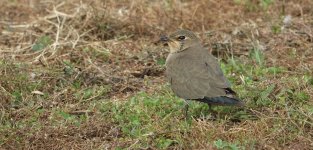 DSC04780 Oriental Pratincole @ RDBT.JPG686.6 KB · Views: 66
DSC04780 Oriental Pratincole @ RDBT.JPG686.6 KB · Views: 66 -
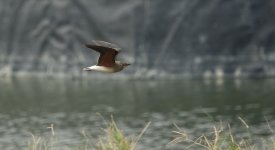 DSC04801 Oriental Pratincole @ RDBT.JPG326 KB · Views: 56
DSC04801 Oriental Pratincole @ RDBT.JPG326 KB · Views: 56 -
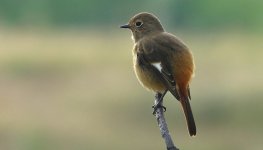 DSC04737 Daurian Redstart @ RDBT.JPG406.8 KB · Views: 58
DSC04737 Daurian Redstart @ RDBT.JPG406.8 KB · Views: 58 -
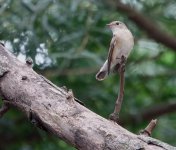 DSC04889 Red-breasted Flycatcher @ RDBT.jpg187.3 KB · Views: 65
DSC04889 Red-breasted Flycatcher @ RDBT.jpg187.3 KB · Views: 65 -
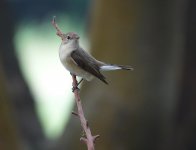 DSC04893 Red-breasted Flycatcher @ RDBT.JPG274.7 KB · Views: 56
DSC04893 Red-breasted Flycatcher @ RDBT.JPG274.7 KB · Views: 56
MKinHK
Mike Kilburn

Last week was altogether quieter, with a Yellow Wagtail seen from the bus and a Black-faced Bunting on the edge of the golf course being the only additions to the list for this quarter, which now stands at 72. I got out on the first three days of the week and some of the quality - if not the Black-throated Thrush - had remained the Red-breasted and Taiga Flycatchers are still entertaining on the Core Area, the Eye-Browed and Grey-backed Thrushes remain, as does the Blue Whistling Thrush and the Oriental Pratincole was on the golf course until at least Tuesday.
I've also included a shot of the Pacific Reef Egret loafing on the landing lights jetty with a couple of Grey Herons.
Cheers,
Mike
I've also included a shot of the Pacific Reef Egret loafing on the landing lights jetty with a couple of Grey Herons.
Cheers,
Mike
Attachments
MKinHK
Mike Kilburn

Another few quieter days on the patch, although I did add a Wryneck on the Core Area to the list for the quarter yesterday and the Red-breasted Flycatcher is looking well settled with three weeks under the belt already.
Other than that the Black-naped Monarch and at least one Taiga Flycatcher are still knocking about and Magpie made a rare appearance on the Roundabout itself at lunchtime today, and I twice had glimpses of a male Grey-backed Thrush and what might have been the tail of the Blue Whistling Thrush.
I think the clear-out has to do with the water in the ditch drying out, so some rain to provide a supply of water would be most helpful.
Cheers
Mike
Other than that the Black-naped Monarch and at least one Taiga Flycatcher are still knocking about and Magpie made a rare appearance on the Roundabout itself at lunchtime today, and I twice had glimpses of a male Grey-backed Thrush and what might have been the tail of the Blue Whistling Thrush.
I think the clear-out has to do with the water in the ditch drying out, so some rain to provide a supply of water would be most helpful.
Cheers
Mike
Last edited:
MKinHK
Mike Kilburn

Well my wish for more rain to fill the ditch again duly materialised, and my two visits last week included the female Black-naped Monarch, Asian Brown Flycatcher and a Taiga Flycatcher, plus a couple of Grey-backed Thrushes. The highlight was a Brownish-flanked Bush Warbler on Friday lunchtime - a bird I missed in the last recording year and one which I only seem to see once once in any given winter. Other winter birds included a Daurian Redstart and a Fork-tailed Sunbird on the Western Tangle.
Regular species included Magpie Robin, White Wagtail, Tree Sparrow, Large-billed Crow, Chinese and Crested Bulbuls, Black-necked Starling and Crested Myna, Eastern Great Tit, Common Tailorbird, Dusky, Yellow-browed and Pallas's Leaf Warblers, Spotted Dove, a Long-tailed Shrike a Richard's Pipit, and the usual flock of Olive-bakced Pipits on the Grassy Verge. There are still plenty of Great and Little Egrets in the bay.
The loss of the golf course seems to have have a greater overall impact across the site - Block Rock Thrushes of both races are yet to be seen this is winter, Blackbirds are scarce, and there has been no sign of any interesting races of White Wagtail.
Cheers
Mike
Regular species included Magpie Robin, White Wagtail, Tree Sparrow, Large-billed Crow, Chinese and Crested Bulbuls, Black-necked Starling and Crested Myna, Eastern Great Tit, Common Tailorbird, Dusky, Yellow-browed and Pallas's Leaf Warblers, Spotted Dove, a Long-tailed Shrike a Richard's Pipit, and the usual flock of Olive-bakced Pipits on the Grassy Verge. There are still plenty of Great and Little Egrets in the bay.
The loss of the golf course seems to have have a greater overall impact across the site - Block Rock Thrushes of both races are yet to be seen this is winter, Blackbirds are scarce, and there has been no sign of any interesting races of White Wagtail.
Cheers
Mike

The upshot is that if this record is accepted it would be the first record for Hong Kong. Watch this space!
Not bad for a grotty little roundabout in the middle of an international airport
Mind you, looking at the birds you record and, even more, all the photographs (of birds in thick undergrowth and to watery backdrops, etc), I am ever more convinced this entire thread is a fraud - this is no few square metres of airport outers, it is the depths of some exotic Asian rainforest :-O
Come on Mike, come clean ....
Users who are viewing this thread
Total: 6 (members: 0, guests: 6)




